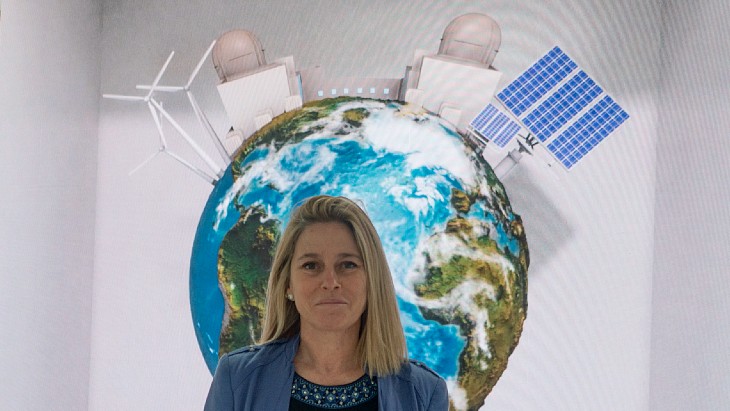Viewpoint: Bilbao y León reflects on nuclear's presence at COP27
29 November 2022
Sharm El-Sheikh marked the first time the global nuclear community had a large pavilion in the Blue Zone, at the heart of COP27, writes World Nuclear Association Director General Sama Bilbao y León. The pavilion, a partnership between the International Atomic Energy Agency (IAEA), World Nuclear Association and other nuclear organisations, was a focal point where people could visit and enquire about nuclear energy and the nuclear industry.

Sama Bilbao y León at COP27 (Image: World Nuclear Association)
But most of all, the pavilion allowed us to host a robust programme of panel discussions, speeches, film screenings, presentations and interviews where we presented the reasons why nuclear energy is - and needs to continue to be - an essential piece of the climate change solution.
From the point of view of the political negotiations, the main development at COP27 was the agreement to set up a Loss and Damage fund, that would provide finance to poorer countries affected by the negative impacts of climate change. On the other hand, it was acknowledged that very little progress was made on reducing greenhouse gas emissions. Without such progress the impacts of climate change will only get worse. Governments need to take action with pragmatic, implementable action plans to go from where we are right now to where we need to be.
There was one promising development. Where earlier drafts of the Sharm el-Sheikh Implementation Plan referred only to deep, rapid and sustained reductions in global greenhouse gas emissions through "increase(d) renewable energy" the final text referred more broadly to "low-emission and renewable energy". This clearly includes nuclear energy. However, the continued omission of text referring to the need for more nuclear energy in the COP agreements remains a failing driven by ill-conceived political obstruction.
On our side, we at World Nuclear Association will continue working together with our members, with the global nuclear industry, to put in place the frameworks that are needed to make the most of the existing nuclear fleet, and to accelerate the deployment of new nuclear globally.
This includes working together with governments, with regulators and other international organisations. This also means supporting the nuclear industry as it jointly develops a secure global supply chain that is truly global and able to help us deliver nuclear energy at the speed and scale needed.
And this also includes working together with policymakers, to help them put in place bold, actionable, pragmatic, technology-neutral policies that are going to recognise the essential role of nuclear energy, and are going to incentivise long-term planning and investment.
This also includes working together with the finance community, because it is essential that nuclear power is recognised as an investable, sustainable asset.
At the pavilion we spoke with global leaders, with policymakers, with activists and with the finance community, as well as with members of civil society who just came to learn more about nuclear energy. As this was very successful, we still can do much more to make sure that nuclear energy is part of the mainstream climate change discussion.
World Nuclear Association, in cooperation with the Canadian Nuclear Association, the Japan Atomic Industrial Forum (JAIF), Nucleareurope and the Nuclear Energy Institute, curated a programme of ten events covering issues such as finance, innovation in nuclear, decarbonisation beyond electricity, and the experiences of women working in clean energy. I was particularly pleased to host our final event where I interviewed a very diverse range of energy experts from the Clean Air Taskforce, the World Energy Council, the International Hydro Association, Women in Renewable Energy, influencers as filmmaker Tyson Culver as well as nuclear colleagues from Urenco, Emirates Nuclear Energy Corporation, Rolls-Royce, Pillsbury and JAIF.
I was also pleased to participate in two official United Nations Framework Convention on Climate Change side events, one of which brought together three UN organisations - IAEA, the United Nations Economic Commission for Europe and the United Nations Industrial Development Organisation - to recognise the essential role of nuclear energy in addressing decarbonisation and sustainable development. In the second, leaders of the nuclear trade associations spoke after an opening interview with US Energy Secretary Jennifer Granholm.
I also had the opportunity to contribute to an event organised by the Egyptian Nuclear Power Plant Authority highlighting the El Dabaa nuclear power plant as an indispensable element of the clean energy and economic development future of Egypt.
While we invited a broad range of people to take part in our events, at future COPs we need to do more to take our messages to other pavilions and venues to make sure we are not just speaking to ourselves, and are getting our message to a broader audience.
We must do this because I truly think that nuclear energy offers a golden opportunity to decarbonise not just electricity, but the entire economy, and do it in a way that is cost-effective and equitable. With nuclear energy, we can provide abundant, affordable, clean, 24/7 energy to everyone, everywhere.